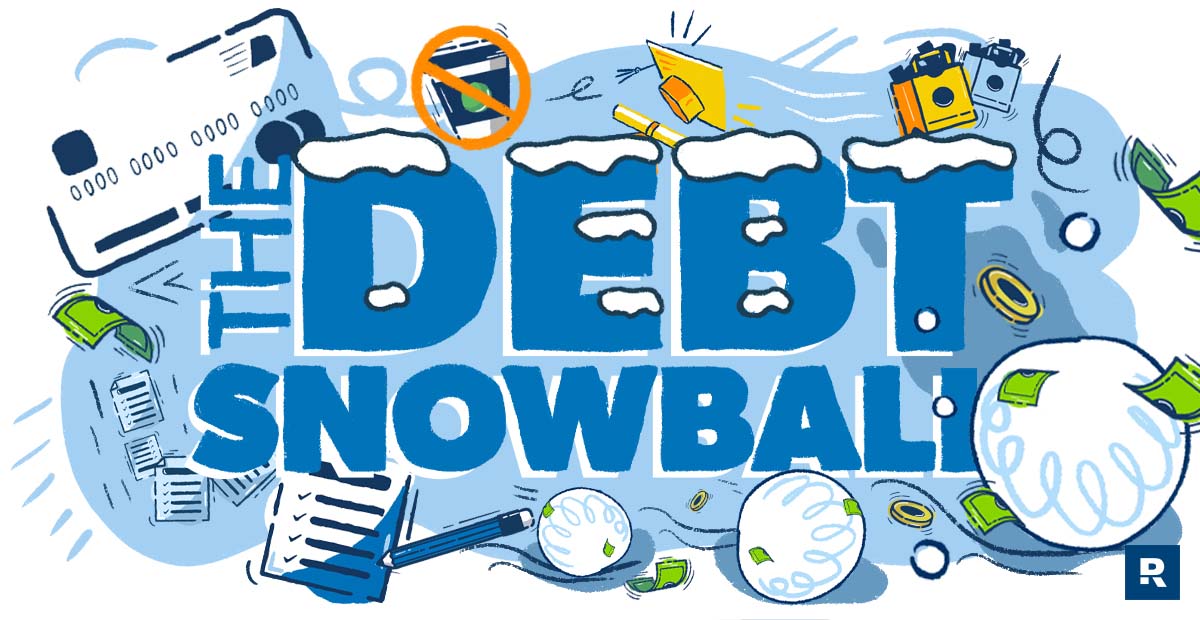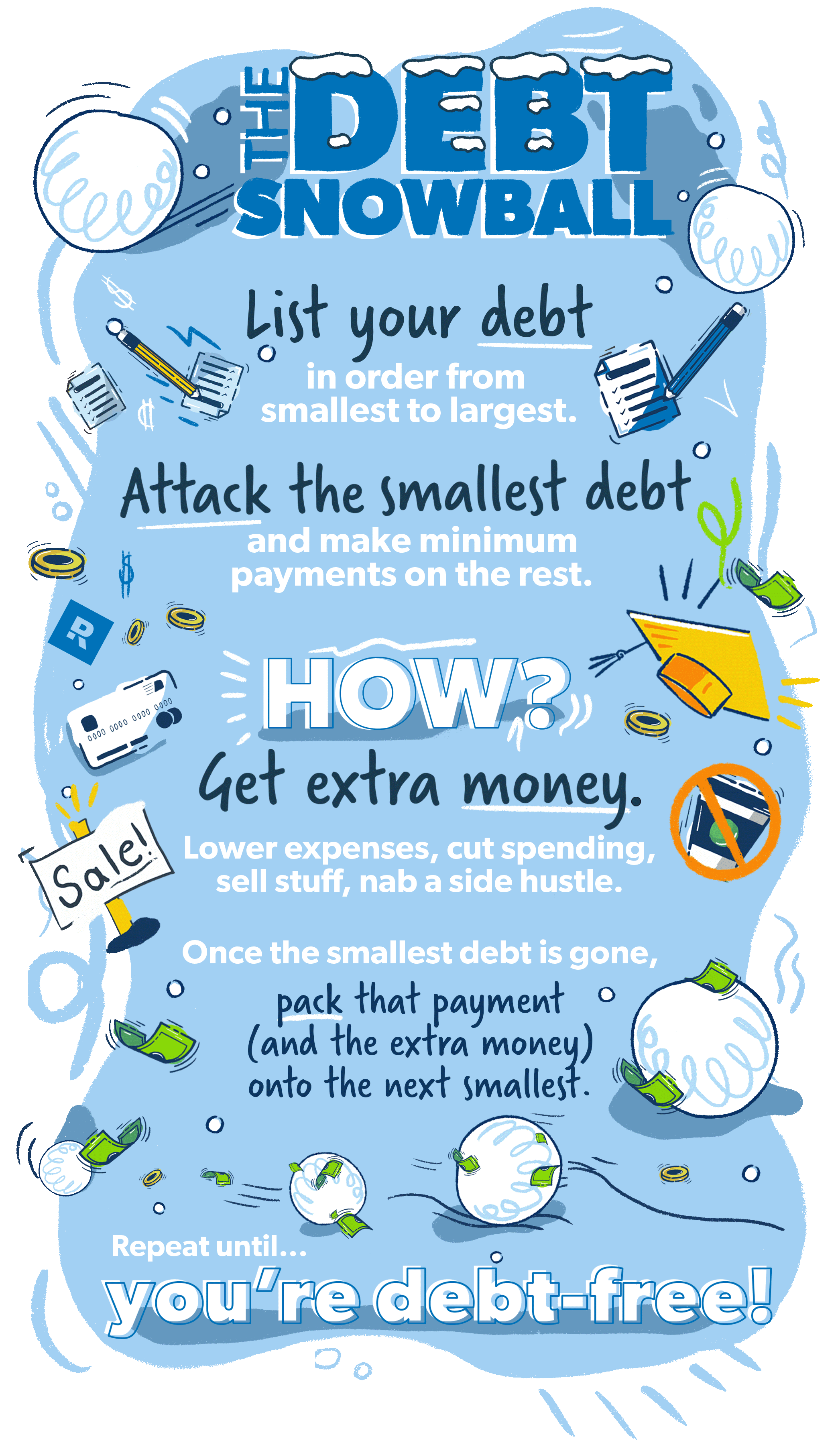
If you’re looking for a way to get out of debt for good, let me introduce you to your new DFBFF (debt freedom best friend forever): the debt snowball.
The debt snowball method is the fastest way to pay off your debt. It’s how I paid off $40,000 of consumer debt in just 18 months! And if it worked for me, it’ll work for you too.
If you’re following Dave Ramsey’s 7 Baby Steps, you know that Baby Step 2 is to pay off all debt (except your house) using the debt snowball. So, once you’re current on all your bills and have $1,000 saved for your starter emergency fund, it’s time to get that snowball rolling!
How Does the Debt Snowball Method Work?
The debt snowball method is a debt-reduction strategy where you pay off debt in order of smallest balance to largest balance, gaining momentum as you knock out each balance. When the smallest debt is paid in full, you roll the minimum payment you were making on that debt into the next-smallest debt payment.
Here’s how the debt snowball works:
Step 1: List your debts from smallest to largest (regardless of interest rate).
Step 2: Make minimum payments on all your debts except the smallest debt.
Step 3: Throw as much extra money as you can on your smallest debt until it’s gone.
Step 4: Take what you were paying on your smallest debt and add that to your payment on the next-smallest debt until it’s gone too.
Step 5: Repeat until each debt is paid in full and you’re completely debt-free!
As you knock out your debts one by one, the amount of money you have to throw at the rest of your debt grows—kind of like a snowball rolling down a hill (hence the name). And the excitement you get from paying off your smallest debt super quick will motivate you to keep plowing through your debt, all the way to that debt-free finish line!
Why Does the Debt Snowball Method Work?
The debt snowball works because it’s all about changing your behavior. Trust me, you don’t need to have a finance degree or be a mathlete to beat debt. Your mindset has more to do with this equation than math ever will. In fact, personal finance is 80% behavior and only 20% head knowledge.
The quick wins you get with the debt snowball help you believe you can actually pay off your debt. And if you believe it, you’ll start behaving like it. That’s why it worked for me. Once I saw my smallest credit card debt get knocked out, I did a little happy dance (internally—you don’t want to see me dance externally). And my brain was like, That was awesome! Let’s do it again! That’s the power of psychology—and the debt snowball.
What About the Interest Rates?
Maybe you’ve heard of the debt avalanche method, where you pay your debts in order from highest to lowest interest rate. But here’s the deal: If you start paying on your debt with the highest interest rate first (which is usually also your biggest balance), it could be a while before you see any progress.
Pretty soon, you’ll lose steam and maybe give up altogether. Why? Because it’s taking forever to gain traction! You’ve started with the hardest debt, instead of the easiest. Plus, you’ll still have all your other small, annoying debts hanging around that you also have to keep paying on.
Pay off debt fast and save more money with Financial Peace University.
But when you knock out the smallest debt first, you get a win much faster! That debt is out of your life forever. The second debt will soon follow and then the next and the next. Suddenly, you’re throwing a monster snowball of a payment at your last debts—instead of chipping away with bite-sized minimum payments.
When you see your debt snowball actually working, you’re more likely to stick with it. And the next thing you know, you’ll be screaming, “I’m debt-free!”
An Example of the Debt Snowball
Now, let’s see an example of how this method works in real life. In this scenario, you’ve got four different debts:
- $500 medical bill—$50 payment
- $2,500 credit card debt—$63 payment
- $7,000 car loan—$135 payment
- $10,000 student loan—$96 payment
Using the debt snowball method, you’d make minimum payments on everything except the $500 medical bill—that’s the one you attack with a vengeance. And let’s say you’re super focused on your goal, so you get a side hustle, bringing in an extra $500 each month that you add to your snowball.
Since you’re paying $550 a month on the medical bill (the $50 minimum payment plus the extra $500), that debt is completely gone in one month. Boom! Now you can take the freed-up $550 and put it toward your credit card debt, paying a total of $613 ($550 plus the $63 minimum payment). In about four months, you’ll be kissing that credit card debt goodbye.
Next, you’ll punch that car loan in the face to the tune of $748 a month ($613 plus $135). In less than nine months, you’ll be driving off into the sunset in a vehicle you actually own.
By the time you reach your last (and biggest) debt, you’ve gotten serious and decided to cut your spending even more, giving you an extra $100 a month. So, now you can put $944 a month toward that dreaded student loan! With a hefty payment like that, you’ll be sending Sallie Mae packing her bags just nine months later.
Do you see now why the debt snowball is the best debt payoff method out there? Paying off your debt in the right order, throwing extra money into your snowball, and staying focused on your goal—that’s how you pay off $20,000 in less than 24 months. And chances are, you’ll probably get so fired up along the way that you pay off your debt even faster!
How to Stay Motivated Working the Debt Snowball
The debt snowball method works. But I’ll be honest, it’s not a cake walk or a walk in the park. In fact, there’s no cake or walking involved here. It’s going to take hard work, sacrifice, budgeting—and constantly telling yourself, We have food at home.
If you’re ready to get rid of your debt once and for all, check out Financial Peace University (FPU). You’ll learn how to use the debt snowball to pay off all your debt. Faster. Than. Ever. And it’s the same class that helped me go from broke to millionaire in a decade.
The best part is having a community of people who are on the same journey as you! That accountability and encouragement helps you stay motivated until you make that final payment.
Listen, the average household who takes FPU pays off $5,300 in the first 90 days. That’s not chump change! So, sign up for an FPU class today.
Just like the snowball gaining speed on its way down the hill, you can power through paying off debt. And when you no longer have debt holding you back, you’re free to save for your future and build the life you really want.
You’ve got this!
The Best Personal Finance Class at the Best Price
Financial Peace University is the fastest way to beat debt and build wealth. Don’t miss this limited-time sale!



